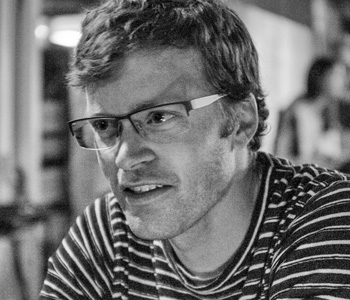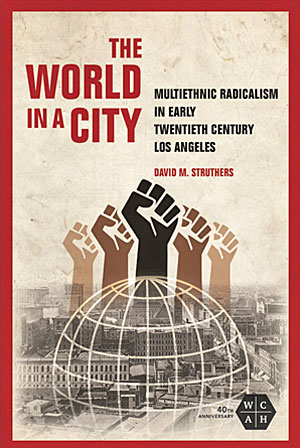
The near-continuous movements of people and of ideas are two themes that flow through the work. Migration from within the United States and across international boundaries increased the population of Los Angeles from roughly one hundred thousand in 1900 to over one million people in 1930. This created one of the most racially diverse places in terms of breadth in the United States and probably the world in this period. The new arrivals filtering into the city formed multiracial working-class neighborhoods.
An important thing to recognize about Los Angeles is that it had a very small industrial sector before 1920; the regional agricultural economy was far more advanced in terms of scale and corporate organization. This shaped migratory labor patterns typified by urban-rural and rural-rural movement where itinerate workers migrated between seasonal agriculture jobs and infrastructure work—things like laying railroad tracks, building roads, and digging aqueducts—and then back to “winter” in Los Angeles or other locations. As the city’s population increased, migration continued for a large sector of the population.
As workers traveled, they formed social connections at the sites of their labor, along the path of their journeys, and independent of their work in places often hundreds of miles away; they formed communities as dispersed, flexible, and mobile as their lives. The mobile working class extended the reach of Los Angeles’ diverse urban community through layers of interconnected social ties that reached throughout the U.S. West and Mexico and into the broader world. Radical political ideals carried by people and print traversed the same commodity and migration networks into and out of Los Angeles.
My interest lies in the alliances people formed to improve their lives in this period of settler colonialism and U.S. imperialism. The most racially diverse coalitions formed among workers with precarious employment and living situations in spaces with weak organizational structures, fueled by the ideals advanced in anarchism—especially by the Partido Liberal Mexicano—the syndicalism of the Industrial Workers of the World (IWW), and socialist internationalism. Radicals generated novel forms of multilingual and interracial organizing by rearticulating anti-statist and internationalist streams of thought to create a local internationalism rooted in place. These practices had a broad cultural impact.
The radical practices that germinated in and near Los Angeles gave rise to some of the broadest interracial solidarities in the history of the United States as Mexicans, European immigrants, Japanese, South Asians, African Americans, indigenous, and native-born whites often found cause for cooperation. Though these solidarities constantly reformed, shifted, and dissolved in a multiracial city during a period of remarkable economic development and population growth. Radicals did not reverse the powerful economic forces and racist logics fueling Los Angeles’ rapid growth, but their organizing provided important outlets for working-class people to shape their lives with hope for a better world.
The book opens its aperture to capture forms of interracial organizing and interaction that might otherwise be dismissed as fleeting and insignificant; the mobility of workers often made solidarities and coalitions short-lived. I use the anarchist notion of affinity to give form to the myriad cooperative actions that shaped the social practices of resistance at street corners and the plaza listening to speakers, rural job sites, jungle camps, boxcars, and in military action during the Mexican Revolution.
Many writers and scholars over time have used affinity to different ends, something that I briefly examine in the introduction. I found the most utility in centering the voluntary associations of anarchists and then extending that frame to looking at temporary sites of struggle. I’m not concerned with things like party membership or carrying a union card; I followed the action through the radical and labor networks that ran through Los Angeles. This approach maintains focus on the continuity of organizing practices across space and borders, while tracing changing solidarities, associations, and organizations that formed and dissolved through struggle, repression, and factionalism.
The book grew out of a suggestion from a friend to read Regeneración, the newspaper published by the Partido Liberal Mexicano, a group that was anarchist, despite having the word ‘liberal’ in its name. They told me about the paper’s Italian column and how interconnected Mexican and Italian radicals were in Los Angeles. I found that and more as my research carried on. The difficult part was understanding the significance of near-continuous interracial organizing through discontinuous organizations. For example, the Japanese Mexican Labor Association in Oxnard, probably the first multiracial union in California, lasted a season or two, yet during the height of its dramatic strike against beet growers it sent a Japanese organizer to Los Angeles to assist the still forming Unión Federal Mexicana in 1903. Neither union survived these initial organizing drives. Similarly, the IWW led a free speech fight in Fresno in autumn 1910, during which some of the participants joined the Mexican Revolution in Baja California in spring 1911. After defeat by federal forces loyal to Francsico Madero, the remnants of the combatants stayed in San Diego and fed into the IWW free speech fight there in 1912.
It took me time to figure out how to tell these stories and discover their interconnections. In the end I settled on using affinity to move interracial solidarity to the role of protagonist; its opponents were racism and nationalism as they remain today. I think it is fair to say that the greatest success of the period was the continuity of interracial organizing rather than the effectiveness of any single job action or moment of revolutionary struggle. I also believe that the inclusive organizing practices developing during this period are at least as significant as any single job action or moment of revolutionary struggle.
I’d suggest opening the book to Chapter 6 on the Baja Raids. In winter and spring 1910/1911 the Partido Liberal Mexicano (PLM) organized a military incursion across the U.S.–Mexico border in Baja California during the opening of the Mexican Revolution. This was part of an upsurge in radical and militant actions in California and the borderlands between 1910 and 1912, including the Los Angeles Times bombing, Fresno’s IWW free-speech fight, and the bombing of Los Angeles’s Llewellyn Iron Works.
This chapter details regional coalition building and the transnational support structure for the Baja Raids. Fighting began in Mexicali when a group of less than twenty Mexicans slipped across the border and seized the town’s jail. Word quickly spread and a group of white and African Americans, mostly IWW members, soon joined the fight. Eventually anarchists and adventurers from across the United States and Canada made the journey. Many were European immigrants from England, Russia, Germany, Sweden, and France, with Italians of special significance. Australians, Boers, Chinese, and Japanese also joined. Pandurang Khankhoje from the South Asian Ghadar Movement even paid a visit to the front lines. Large numbers of Native Americans also fought, including Cocopah, Diegueño, Kiliwa, and Papai. The force’s international composition remained unmatched until antifascist organizing during the Spanish Civil War and its interracial dimension was still more significant.
The racial diversity of participants increased the overall number of rebels and contributed to the effectiveness of the military force. But conflicts between rebels and then with the adventurers and interlopers who crossed the border contributed to questions over the legitimacy of the raids. These conflicts arose as it became clear that the Baja California front was a sideshow to the Mexican Revolution and that the PLM leaders in Los Angeles, though they had many supporters and sympathizers, did not exert direct control over militias anywhere else in Mexico.
I argue that the lack of military or political success of the cosmopolitan army should not constrain the historical legacy of the PLM-led insurgency in Baja California. The PLM functioned as a funnel of interracial internationalism during the outbreak of the Mexican Revolution by channeling financial and material resources and people through Los Angeles. The flows of people and ideas back out through the connected movement increased the scale of discord over its failure in the years that followed.
The Baja raids are an example of the potential of militant cosmopolitan revolutionary action. They are also a cautionary tale of the difficulties of bringing such a diverse group together—on the front lines of battle and mediated through print to a global movement—with an impulse for internationalism yet little understanding of the distinct cultural and ideological differences in what people most often viewed as their shared revolutionary struggle.
The book has distinct lessons for different audiences. For historians and other scholars, I think that affinity is a useful tool applicable to other periods and locations. There are many instances of racial divisions being altered by distinct local power relationships. Two quick examples: A “sawbuck equality” developed between enslaved and owners in South Carolina in the late 1700s, and the cosmopolitan lower decks of ships in the Atlantic during the Age of Revolution provided space for whites, blacks, and many others to find common ground. Affinity can help us understand flexible forms of association in relation to race, power, and states.
For most readers, the implication is that the broadest moments of interracial organizing were brief and came outside of hierarchical organizations. Stronger power structures focused institutional power to enforce racism in these organizations and parties. Interracial affinities developed their broadest form in places that lacked the organizational structures to enforce racist exclusion. When whites in these spaces held deeply racist beliefs, they had less power to act upon these beliefs; all the while, the structural manifestations of race still organized society and the economy.
In our era of increasingly vocal racism and nationalism, the book has a powerful story to tell about people that fought to create a world counter to these noxious beliefs. One place for us to start is learning that the mix of organizers, workers, and migrants in the book didn’t have superpowers. They didn’t have it all figured out, but what they knew was that to make a better world was to struggle. In the end, we can all work to continue their rich cultural tradition of mutual solidarity. Anarchists, syndicalists, and socialists brought interracial, multilingual, and international organizing to the center of regional working-class culture through their struggle to bring their visions of a new social and economic order into reality. It’s up to us to retranslate these practices and invent our own today. This book illustrates that the pull of cooperation could be stronger than the will for division for many residents of Los Angeles. Only through struggle can we make a culture of affinity as much their legacy as our own.


David Struthers is a historian with interdisciplinary pursuits including radicalism, immigration, race, cities, and media. David received their PhD in history from Carnegie Mellon University. Based in Copenhagen, Denmark, David has lectured at the University of Copenhagen and the Copenhagen Business School over the last ten years. Their monograph, titled The World in a City: Multiethnic Radicalism in Early Twentieth Century Los Angeles (University of Illinois Press, 2019), explores the dynamics of a city and region with a rapidly developing economy and large-scale immigration. The book just won the Shelley Fisher Fishkin Prize from the American Studies Association (2019). Their volume Wobblies of the World: A Global History of the IWW (Pluto Press, 2017), edited with Peter Cole and Kenyon Zimmer, is the first global history of the Industrial Workers of the World. David is currently working on a monograph on the history of social media before the Internet.